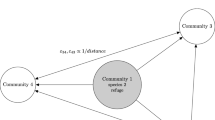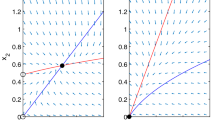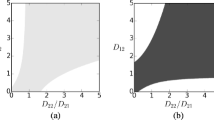Abstract
The source-sink dynamics is a major hypothesis to explain dispersal-mediated coexistence of locally exclusive competitors. We study Lotka-Volterra diffusive models of indirect competition in patchy metacommunities. In a model of exploitative competition, we numerically show that the effect of resource movement on the coexistence depends on demographic factors that create source-sink structures and that the dispersal rate of the superior competitor need not be higher than that of the inferior to promote dispersal-mediated coexistence. In a model of apparent competition, we analytically prove that dispersal can make coexistence possible even if any patches are sinks for the inferior resource species. The requirement for this coexistence is the lower dispersal rate of the inferior competitor. We conclude that dispersal among patches can be a mechanism to save inferior indirect competitors from regional extinction and that the level of spatial heterogeneity need not be so high to reverse the competitive rankings among patches.
Similar content being viewed by others
References
P. Abrams and W.G. Wilson, Coexistence of competitors in metacommunities due to spatial variation in resource growth rates; does R* predict the outcome of competition? Ecol. Lett.,7, (2004) 929–940.
F.R. Adler and J. Mosquera, Is space necessary? Interference competition and limits to biodiversity, Ecology,81, (2000) 3226–3232.
P. Amarasekare, Competitive coexistence in spatially structured environments: a synthesis. Ecol. Lett.,6, (2003) 1109–1122.
P. Amarasekare, M.F. Hoopes, N. Mouquet and M. Holyoak, Mechanisms of coexistence in competitive metacommunities. Am. Nat.,164, (2004) 310–326.
P. Amarasekare and R.M. Nisbet, Spatial heterogeneity, source-sink dynamics, and the local coexistence of competing species. Am. Nat.,158, (2001) 572–584.
R.A. Armstrong and R. McGehee, Competitive exclusion. Am. Nat.,115, (1980) 151–170.
B.M. Bolker and S.W. Pacala, Spatial moment equations for plant communities: understanding spatial strategies and the advantages of short dispersal. Am. Nat.,153, (1999) 575–602.
J.H. Brown and A. Kodric-Brown, Turnover rates in insular biogeography: effect of immigration on extinction. Ecology,58, (1977) 445–449.
V. Calcagno, N. Mouquet, P. Jarne and P. David, Coexistence in a metacommunity: the competition-colonization trade-off is not dead. Ecol. Lett.,9, (2006) 897–907.
R.S. Cantrell and C. Cosner, On the effects of spatial heterogeneity on the persistence of interacting species. J. Math. Biol.,37, (1998) 103–145.
J.M. Chase, P. Amarasekare, K. Cottenie, A. Gonzalez, R.D. Holt, M. Holyoak, M.F. Hoopes, M.A. Leibold, M. Loreau, N. Mouquet, J.B. Shurin and D. Tilman, Competing theories for competitive metacommunities. Metacommunities: Spatial Dynamics and Ecological Communities, (M. Holyoak, M.A. Leibold and R.D. Holt eds.), Chicago University Press, Chicago, 2005, 335–354.
P. Chesson, Coexistence of competitors in spatially and temporally varying environments: a look at the combined effects of different sorts of variability. Theor. Popul. Biol.,28, (1985) 263–287.
P. Chesson, General theory of competitive coexistence in spatially-varying environments. Theor. Popul. Biol.,58, (2000) 211–237.
P. Chesson, Mechanisms of maintenance of species diversity. Annu. Rev. Ecol. Syst.,31, (2000) 343–366.
U. Dieckmann, R. Law and J.A.J. Metz (eds.), The Geometry of Ecological Interactions: Simplifying Spatial Complexity, Cambridge University Press, Cambridge, 2000.
I.A. Hanski and M.E. Gilpin, Metapopulation dynamics: brief history and conceptual domain. Biol. J. Linn. Soc,42, (1991) 3–16.
I.A. Hanski and M.E. Gilpin (eds.), Metapopulation Biology: Ecology, Genetics, and Evolution. Academic Press, San Diego, 1997
A. Hastings, Disturbance, coexistence, history, and competition for space. Theor. Popul. Biol.,18, (1980) 363–373.
R.D. Holt, Predation, apparent competition, and the structure of prey communities. Theor. Popul. Biol.,12, (1977) 197–229.
R.D. Holt, Spatial heterogeneity, indirect interactions, and coexistence of prey species. Am. Nat.,124, (1984) 377–406.
R.D. Holt, Population dynamics in two-patch environments: some anomalous consequences of optimal habitat selection. Theor. Popul. Biol.,28, (1985) 181–208.
R.D. Holt, Ecology at the mesoscale: the influence of regional processes on local communities. Species Diversity in Ecological Communities: Historical and Geographical Perspectives, (R.E. Ricklefs and D. Schulter eds.), University of Chicago Press, Chicago, 1993, 77–88.
R.D. Holt, J. Grover and D. Tilman, Simple rules for interspecific dominance in systems with exploitative and apparent competition. Am. Nat.,144, (1994) 741–771.
M. Holyoak and S.P. Lawler, The role of dispersal in predator-prey metapopulation dynamics. J. Anim. Ecol.,65, (1996) 640–652.
M. Holyoak and S.P. Lawler, Persistence of an extinction-prone predator-prey interaction through metapopulation dynamics. Ecology,77, (1996) 1867–1879.
M. Holyoak, M.A. Leibold and R.D. Holt editors, Metacommunities: Spatial Dynamics and Ecological Communities. Chicago University Press, Chicago, 2005.
M. Holyoak, M.A. Leibold, N. Mouquet, R.D. Holt, M.F. Hoopes, Metacommunities. A framework for large-scale community ecology. Metacommunities: Spatial Dynamics and Ecological Communities, (M. Holyoak, M.A. Leibold and R.D. Holt, eds.), Chicago University Press, Chicago, 2005, 35–67.
M.F. Hoopes, R.D. Holt and M. Holyoak, The effects of spatial processes on two species interactions. Metacommunities: Spatial Dynamics and Ecological Communities, (M. Holyoak, M.A. Leibold and R.D. Holt eds), Chicago University Press, Chicago, 2005, 35–67.
H.S. Horn and R.H. MacArthur, Competition among fugitive species in a harlequin environment. Ecology,53, (1972) 749–752.
S.B. Hsu, S.P. Hubbell and P. Waltman, Competing predators. SIAM J. Appl. Math.,35, (1978) 617–625.
S.B. Hsu, S.P. Hubbell and P. Waltman, A contribution to the theory of competing predators. Ecol. Monog.,48, (1978) 337–349.
Y. Iwasa and J. Roughgarden, Interspecific competition among metapopulations with spacelimited subpopulations. Theor. Popul. Biol.,30, (1986) 194–214.
K. Kishimoto, Coexistence of any number of species in the Lotka-Volterra competitive system over two patches. Theor. Popul. Biol.,38, (1990) 149–158.
J.M. Kneitel and J.M. Chase, Trade-offs in community ecology: linking spatial scales and species coexistence. Ecol. Lett.,7, (2004) 69–80.
A.L. Koch, Competitive coexistence of two predators utilizing the same prey under constant environmental conditions. J. Theor. Biol.,44, (1974) 387–395.
V.A. Kostitzin, Biologie Mathématique. Collection Armand Colin: Paris, Translated in English by T.H. Savory in 1939. Mathematical Biology. Harrap and Co., London, 1937.
M.A. Leibold, M. Holyoak, N. Mouquet, P. Amarasekare, J.M. Chase, M.F. Hoopes, R.D. Holt, J.B. Shurin, R. Law, D. Tilman, M. Loreau and A. Gonzalez, The metacommunity concept: a framework for multi-scale community ecology. Ecol. Lett.,7, (2004) 601–613.
J. Leon and D. Tumpson, Competition between two species for two complementary or substitutable resources. J. Theor. Biol.,50, (1975) 185–201.
S.A. Levin, Dispersion and population interactions. Am. Nat.,108, (1974) 207–228.
R. Levins, Some demographic and genetic consequences of environmental heterogeneity for biological control. Bull. Entomol. Soc. Am.,15, (1969) 237–240.
R. Levins, Extinction. Some Mathematical Problems in Biology, (M. Gerstenhaber, ed.), American Mathematical Society: Providence RI. 1970, 75–107.
R. Levins and D. Culver, Regional coexistence of species and competition between rare species. Proc. Natl. Acad. Sci. USA,68, (1971) 1246–1248.
N. Mouquet, M.F. Hoopes and P. Amarasekare, The world is patchy and heterogeneous! Trade-off and source-sink dynamics in competitive metacommunities. Metacommunities: Spatial Dynamics and Ecological Communities, (M. Holyoak, M.A. Leibold and R.D. Holt, eds.), Chicago University Press, Chicago, 2005, 237–262.
N. Mouquet and M. Loreau, Coexistence in metacommunities: the regional similarity hypothesis. Am. Nat.,159, (2002) 420–426.
N. Mouquet and M. Loreau, Community patterns in source-sink metacommunities. Am. Nat.,162, (2003) 544–557.
N. Mouquet, T.E. Miller, T. Daufresne and J.M. Kneitel, Consequences of varying regional heterogeneity in source-sink metacommunities, Oikos,113, (2006) 481–488.
S. Muko and Y. Iwasa, Species coexistence by permanent spatial heterogeneity in a lottery model. Theor. Popul. Biol.,57, (2000) 273–284.
S. Muko and Y. Iwasa, Incomplete mixing promotes species coexistence in a lottery model with permanent spatial heterogeneity. Theor. Popul. Biol.,64, (2003) 359–368.
D.J. Murrell and R. Law, Heteromyopia and the spatial coexistence of similar competitors. Ecol. Lett.,6, (2003) 48–59.
T. Namba, Emigration of a population and stability of a prey-predator system. Bull. Assoc. Nat. Sci. Senshu Univ.,11, (1993) 9–20.
T. Namba and C. Hashimoto, Dispersal-mediated coexistence of competing predators. Theor. Popul. Biol.,66, (2004) 53–70.
T. Namba, A. Umemoto and E. Minami, The Effects of Habitat Fragmentation on Persistence of Source-Sink Metapopulations in Systems with Predators and Prey or Apparent Competitors. Theor. Popul. Biol.,56, (1999) 123–137.
A. Okubo and S.A. Levin, Diffusion and Ecological Problems: Modern Perspectives (Interdisciplinary Applied Mathematics). Springer-Verlag, New York, 2001.
S.W. Pacala and M. Rees, Models suggesting field experiments to test two hypotheses explaining successional diversity. Am. Nat.,152, (1998) 729–737.
S.W. Pacala, and J. Roughgarden. Spatial heterogeneity and interspecific competition. Theor. Popul. Biol.,21, (1982) 92–113.
H.R. Pulliam, Sources, sinks, and population regulation. Am. Nat.,132, (1988) 652–661.
H.R. Pulliam and B.J. Danielson, Sources, sinks, and habitat selection: a landscape perspective on population dynamics. Am. Nat.,137, (1991) S50-S66.
A. Schneeberger and V.A.A. Jansen, The estimation of dispersal rates using the covariance of local populations. Ecol. Modell.,196, (2006) 434–446.
N. Shigesada and K. Kawasaki, Biological Invasions: Theory and Practice (Oxford Series in Ecology and Evolution). Oxford University Press, Oxford, New York, 1997.
A. Shmida and R.H. Whittaker, Pattern and biological microsite effects in two shrub communities, Southern California. Ecology,62, (1981) 234–251.
R. Snyder and P. Chesson, Local dispersal can facilitate coexistence in the presence of permanent spatial heterogeneity. Ecol. Lett.,6, (2003) 301–309.
F.M. Stewart and B.R. Levin, Partitioning of resources and the outcome of interspecific competition: a model and some general considerations. Am. Nat.,107, (1973) 171–198.
Y. Takeuchi, Diffusion-mediated persistence in two-species competition Lotka-Volterra model. Math. Biosci.,95, (1989) 65–83.
D. Tilman, Resources: a graphical-mechanistic approach to competition and predation. Am. Nat.,116, (1980) 362–393.
D. Tilman, Resource Competition and Community Structure. Princeton University Press, Princeton, 1982.
D. Tilman, Competition and biodiversity in spatially structured habitats. Ecology,75, (1994) 2–16.
D. Tilman and P. Kareiva, eds., Spatial Ecology: The Role of Space in Population Dynamics and Interspecific Interactions. Princeton University Press, Princeton, 1997.
D. Tilman, R.M. May, C.L. Lehman and M.A. Nowak, Habitat destruction and the extinction debt. Nature,371, (1994) 65–66.
A.R. Watkinson and W.J. Sutherland, Sources, sinks and pseudo-sinks. J. Anim. Ecol.,64, (1995) 126–130.
D.S. Wilson, Complex interactions in metacommunities with implications for biodiversity and higher levels of selection. Ecology,73, (1992) 1984–2000.
D.W. Yu and H.B. Wilson, The competition-colonization trade-off is dead; long live the competition-colonization trade-off. Am. Nat.,158, (2001) 49–63.
Author information
Authors and Affiliations
Corresponding author
About this article
Cite this article
Namba, T. Dispersal-mediated coexistence of indirect competitors in source-sink metacommunities. Japan J. Indust. Appl. Math. 24, 39–55 (2007). https://doi.org/10.1007/BF03167506
Received:
Revised:
Issue Date:
DOI: https://doi.org/10.1007/BF03167506




